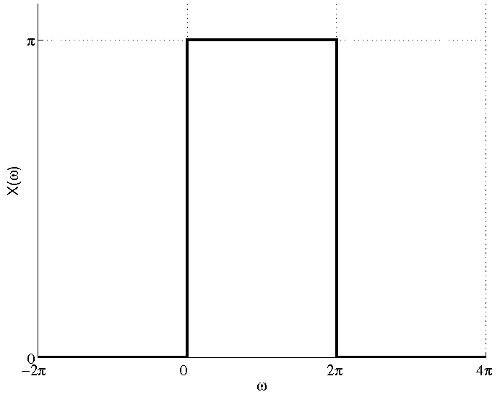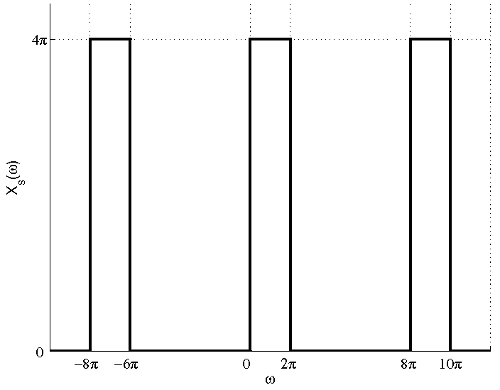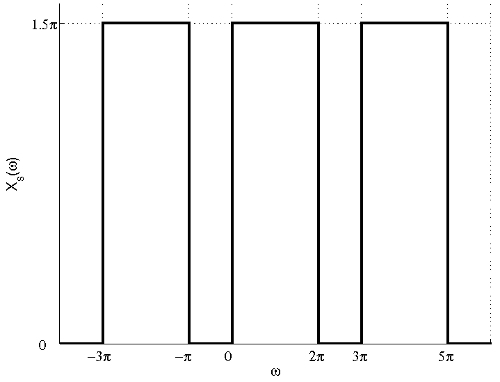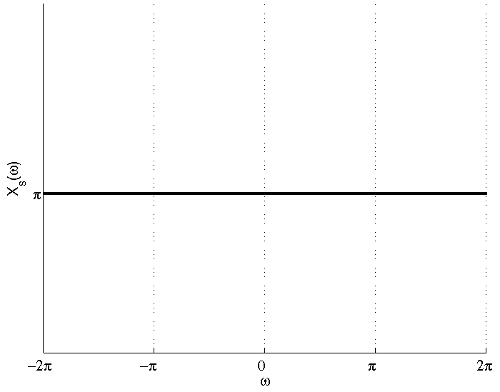(quesiton) |
|||
| Line 42: | Line 42: | ||
<br><br> | <br><br> | ||
| + | There was a typo in the CTFT pairs posted. There is no inherent '2' in the equation for the pair. To reference, the book will confirm this in the tables around page 329. | ||
(d) The given signal has infinite duration and hence it is '''band-limited'''. | (d) The given signal has infinite duration and hence it is '''band-limited'''. | ||
Revision as of 06:24, 21 April 2011
Contents
Homework 9 Solutions, ECE301 Spring 2011 Prof. Boutin
Students should feel free to make comments/corrections or ask questions directly on this page.
Question 1
(a) The given signal has finite duration and hence it is not band-limited.
(b) The given signal has finite duration and hence it is not band-limited.
(c) The given signal has infinite duration and hence it is band-limited.
$ x(t)=\frac{\sin(3\pi t)}{t}=\pi\frac{\sin(3\pi t)}{\pi t} $
$ \begin{align} \mathcal{X}(\omega)&=\pi \cdot \mathfrak{F}\left\{\frac{\sin(3\pi t)}{\pi t}\right\} \\ &=\left\{\begin{array}{ll} \pi , & \mbox{ for } |\omega|<3\pi \\ 0, & \mbox{ elsewhere} \end{array}\right. \end{align} $
Thus the Nyquist rate of this signal is $ \omega_s=2(3\pi)=6\pi $.
QUESTION: I know that the answer to this isn't necessary to answer the question, but if the transform pair says that
$ \frac{2 \sin \left( W t \right)}{\pi t } \ $ transforms to $ \left\{\begin{array}{ll}1, & \text{ if }|\omega| <W,\\ 0, & \text{else.}\end{array} \right. \ $,
then why does the F.Transform not account for the factor of "2" in front in the answers above and below?
Should the answers not take the following form:
$ \begin{align} \mathcal{X}(\omega)&=\pi/2 \cdot \mathfrak{F}\left\{\frac{2\sin(3\pi t)}{\pi t}\right\} \\ &=\left\{\begin{array}{ll} \pi/2 , & \mbox{ for } |\omega|<3\pi \\ 0, & \mbox{ elsewhere} \end{array}\right. \end{align} $
?
There was a typo in the CTFT pairs posted. There is no inherent '2' in the equation for the pair. To reference, the book will confirm this in the tables around page 329.
(d) The given signal has infinite duration and hence it is band-limited.
$ x(t)=\frac{\sin(3\pi(t+5))}{t+5}=\pi\frac{\sin(3\pi(t+5))}{\pi(t+5)} $
$ \begin{align} \mathcal{X}(\omega)&=\pi \cdot \mathfrak{F}\left\{\frac{\sin(3\pi (t+5))}{\pi (t+5)}\right\} \\ &=\left\{\begin{array}{ll} \pi e^{5j\omega} , & \mbox{ for } |\omega|<3\pi \\ 0, & \mbox{ elsewhere} \end{array}\right. \end{align} $
Thus the Nyquist rate of this signal is $ \omega_s=2(3\pi)=6\pi $.
Question 2
$ x(t)=e^{j\pi t}\frac{\sin(\pi t)}{t}=\pi e^{j\pi t}\frac{\sin(\pi t)}{\pi t} $
Using frequency shift property of FT, we get:
$ \begin{align} \mathcal{X}(\omega)&=\left\{\begin{array}{ll} \pi , & \mbox{ for } |\omega - \pi|<\pi \\ 0, & \mbox{ elsewhere} \end{array}\right. \\ &=\left\{\begin{array}{ll} \pi , & \mbox{ for } -\pi <\omega-\pi<\pi \\ 0, & \mbox{ elsewhere} \end{array}\right. \\ &=\left\{\begin{array}{ll} \pi , & \mbox{ for } 0<\omega<2\pi \\ 0, & \mbox{ elsewhere} \end{array}\right. \end{align} $
The figure below shows the plot of the FT of $ x(t) $.
After sampling with a sampling period T, we get:
$ \mathcal{X}_s(\omega)=\frac{1}{2\pi}\mathcal{X}(\omega)*\mathcal{P}(\omega)=\frac{1}{T}\sum_{k=-\infty}^{\infty}\mathcal{X}(\omega-\frac{2\pi k}{T}) $
(a) The FT of the signal after sampling with sampling period $ T=\frac{1}{4} $ is shown in the figure below.
From the figure, we can see that there is no aliasing and the signal can be recovered by filtering the sampled signal using the following filter:
$ \mathcal{H}(\omega)=\left\{\begin{array}{ll} \frac{1}{4} , & \mbox{ for } 0<\omega<2\pi \\ 0, & \mbox{ elsewhere} \end{array}\right. $
(b) The FT of the signal after sampling with sampling period $ T=\frac{2}{3} $ is shown in the figure below.
From the figure, we can see that there is no aliasing and the signal can be recovered by filtering the sampled signal using the following filter:
$ \mathcal{H}(\omega)=\left\{\begin{array}{ll} \frac{2}{3} , & \mbox{ for } 0<\omega<2\pi \\ 0, & \mbox{ elsewhere} \end{array}\right. $
(c) The FT of the signal after sampling with sampling period $ T=2 $ is shown in the figure below.
From the figure, we can see that there is aliasing and thus the signal cannot be recovered.
Question 3
$ \begin{align} \mathfrak{F}\left\{p(t-3)\right\}&=P(\omega)e^{-3j\omega} \\ &=\omega_se^{-3j\omega}\sum_{k=-\infty}^{\infty} \delta(\omega-\omega_s k) \\ &=\omega_s \sum_{k=-\infty}^{\infty} e^{-3j\omega_s k}\delta(\omega-\omega_s k) \text{ Using sampling property of dirac-delta function} \end{align} $
Let $ x_s(t)=x(t)p(t-3) $, then
$ \begin{align} \mathcal{X}_s(\omega)&=\frac{\omega_s}{2\pi} \mathcal{X}(\omega)*\sum_{k=-\infty}^{\infty}e^{-3j\omega_s k}\delta(\omega-\omega_s k) \\ &=\frac{\omega_s}{2\pi} \sum_{k=-\infty}^{\infty}e^{-3j\omega_s k}\mathcal{X}(\omega-\omega_s k) \\ \end{align} $
Note that the exponential term does not depend on $ \omega $, and that at $ k=0 $ it is 1. Thus:
- if $ \omega_s>2\omega_M $, then the signal can be recovered by passing $ x_s(t) $ through the following filter:
- $ \mathcal{H}(\omega)=\left\{\begin{array}{ll} \frac{2\pi}{\omega_s} , & \mbox{ for } |\omega|<\omega_M \\ 0, & \mbox{ elsewhere} \end{array}\right. $
- if $ \omega_s<2\omega_M $, then there will be aliasing and the signal cannot be recovered.
Question 4
Since $ x(t) $ is sampled with a sampling period $ T_s=\pi/\omega_0 $, then the sampling rate is $ \omega_s=2\omega_0 $ and hence there is no aliasing.
Taking the FT of both sides of the system equation we get:
$ \mathcal{Y}(\omega)=j\omega\mathcal{X}(\omega) $
and hence the frequency response of the CT system is:
$ \mathcal{H}(\omega)=j\omega $
Using the relationship between the frequency response of the CT system and the DT system, we get:
$ \begin{align} \mathcal{H}_d(\omega)&=\mathcal{H}(\frac{\omega}{T_s}) \text{ for }|\omega|<\pi \\ &=j\frac{\omega}{T_s} \text{ for }|\omega|<\pi \end{align} $
Now in order to get the impulse response of the DT system we take the IDTFT of the frequency response above:
$ \begin{align} h_d[n]&=\frac{1}{2\pi}\int_{-\pi}^{\pi}j\frac{\omega}{T_s} e^{j\omega n} d\omega\\ &=\frac{j}{2\pi T_s} \int_{-\pi}^{\pi} \omega e^{j\omega n}d\omega \\ &=\frac{j}{2\pi T_s} \left[\omega \frac{e^{j\omega n}}{jn}\right]^{\pi}_{-\pi} + \frac{j}{2\pi T_s}\left[\frac{e^{j\omega n}}{n^2}\right]_{-\pi}^{\pi} \\ &=\frac{1}{2T_s n} [e^{j\omega \pi}+e^{-j\omega \pi}] + \frac{j}{2\pi T_s n^2}[e^{j \pi n} - e^{-j \pi n}] \\ &=\frac{(-1)^n}{T_s n} \\ &=\frac{\omega_0 (-1)^n}{\pi n} \end{align} $
Note that an impulse response is sufficient to characterize an LTI system.





